This is a recipe for a vegetarian version of Leopard Pie, or “Timballo del Gattopardo”, a classic but obscure Italian dish that could reasonably be called a “macaroni pie”, though it’s very different from the Scottish or West Indies versions. The original Leopard Pie is described by Giuseppe di Tomasi di Lampedusa in his book, The Leopard, and features prodigious quantities of veal, ham, chicken breast, chicken livers and heart, and even unlaid eggs (don’t ask).
And why? Well, with two vegetarians, three meat eaters and one nut allergy in the family, what were we to eat for the main Christmas Day meal? I wanted one main meal for all, rather than doing separate meat and veggie things with even more hassle and washing up. But it would have to be something impressive, because for the last few years (when we were all meat eating) we’ve been used to magnificent roast pork with crackling (always from W George Butchers in Talgarth). With nut roast off the options list, I had to find something that could hold its own as a centrepiece, having the same impact and presence as roast goose or pork. So I settled on a “Leopard Pie”. Now this doesn’t seem promisingly vegetarian at first glance, but I felt it was one of those classic recipes that has one defining feature and can then be adapted creatively. In this case the defining feature is the macaroni (in a pie!). I did a trial run, and this final recipe benefitted from that enormously. But I confess the quantities below may be inaccurate, as the final version used leftover frozen filling from the trial run, augmented with other ingredients, and the final quantities have been adapted but remain largely theoretical until I make it again.
Here’s the finished article, or rather what was left of it on Boxing day!
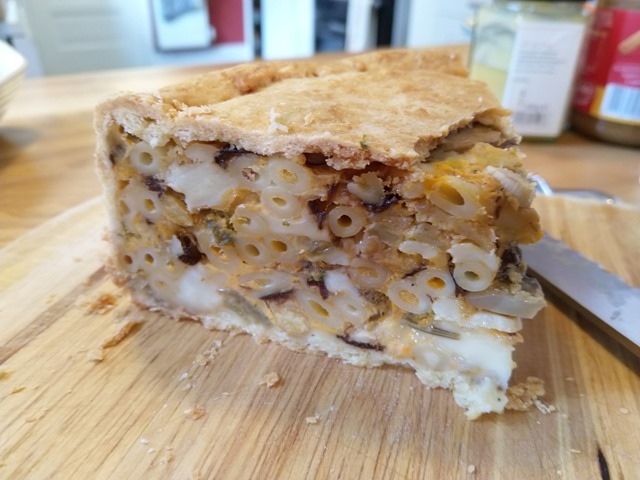
The bulk of the filling is roasted vegetables, egg, various cheeses, and macaroni. I had recently harvested an enormous Musquee de Provence squash from the garden, but I think a butternut would be fine.
The filling can be made in advance, and frozen if required (omitting the eggs, cream, cheeses and macaroni until just before assembling the pie).
Ingredients
300g macaroni
12 quails’ eggs (or 2 good quality eggs if these can’t be found)
6 medium/large good quality eggs
Whipping cream (small pot)
Olive oil
White wine (half a bottle)
A stalk of rosemary
3/4 lb squash (butternut or similar), peeled and de-seeded, chopped into 1 inch chunks
2 onions, in large chunks e.g. 1/8ths
1 large carrot, in large chunks
1 fennel bulb, sliced and chopped
2 sticks of celery, chopped
1/2 lb mushrooms (quartered or sliced)
4 cloves of garlic, crushed and sliced
10 stoned prunes, roughly chopped
1 cinnamon stick or 1/2 teaspoon ground cinnamon
100g grated parmesan cheese
Taleggio cheese (typical half-pound pack, about 200-250g). Limburger/Herve would be a worthy alternative, or possibly Gruyere.
1 Halloumi pack (150g)
Salt and pepper
For the pastry
360g flour
180g butter
1 medium/large egg
Equipment
1 roasting tray, 1 large pan, cheese grater
23cm cake/pie tin, preferably springform
Method
Roast the vegetables with a couple of tablespoons of olive oil, and the rosemary, at 180°C for one hour. After 30 minutes, turn the vegetables and add a glass of white wine and some salt and ground black pepper. After an hour, they should be browned around the edges and well cooked. Set aside, removing any rosemary twigs.
While the vegetables are roasting, fry the mushrooms over a medium heat in a little oil until well browned. Set aside or add to the vegetables.
In the same pan, add a little more oil and the garlic, and fry for a couple of minutes (we don’t want to burn the garlic), then add 2 small glasses of white wine, half a pint of stock, the chopped prunes, the cinnamon stick, a pinch of salt, and simmer for 10 minutes. Turn off the heat and leave to infuse for at least 30 minutes. Then discard the cinnamon stick. If you don’t have a cinnamon stick, add half a teaspoon of ground cinnamon instead.
Combine the above cooked ingredients, and add the grated parmesan. This mixture can be made in advance and frozen or kept in the fridge for a day or two.
Weigh out the flour and butter, roughly chop the butter, place bowl of flour and butter in the freezer for ten minutes. Then whizz in the food processor until mixed. Break the egg into the mix, add a tablespoon of cold water, and pulse to mix until the pastry comes together (a little more cold water might be needed).
Separate into roughly 1/3 and 2/3 portions (lid and base/sides). Roll out thinly between sheets of clingfilm, and line the base and sides of a 23cm tin with the pastry. Allow sufficient height in the sides to fold over the lid when it’s added. Put the tin and the remaining pastry in the fridge until ready to fill.
We’re now going to assemble the filling, so a large pan or mixing bowl is needed. If resuming here with defrosted or chilled mix, we want to reheat the vegetable mixture so it’s warm, without cooking it any more.
Hard boil the quails’ eggs, cool, peel and remove the white. We will add the unbroken yolks to the mixture later. If you can’t find quails’ eggs, just chop the hard-boiled yolks of 2 hens’ eggs.
Cook the macaroni in lots of salted boiling water until just done – this taking exactly 10 minutes for a typical supermarket dried macaroni. Drain, add some olive oil to prevent sticking, and add to the main mix.
Dice the Taleggio into cubes about 1.5-2cm, and give the Halloumi similar treatment though a bit smaller. Add to the mix. We don’t want the Taleggio to melt away at this stage, so the mix should not be too hot.
Separate the yolks of 4 eggs (set aside the whites for something else), mix with two whole eggs and about 100ml whipping cream. Add to the mix.
Add the hard-boiled egg yolks.
The mix should now be moist but without pooling liquid. If it seems dry, add some more white wine and cream.
The seasoning of the filling should be OK already, but use your judgement and add more S&P to taste.
Fill the pie and add the lid, folding over the sides to seal. Prick the lid and brush with egg/milk. Here’s the pie before the lid goes on:
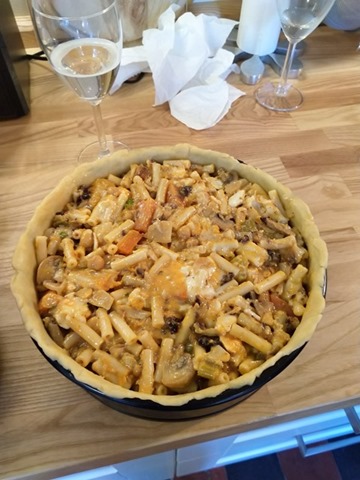
And ready to go in the oven:
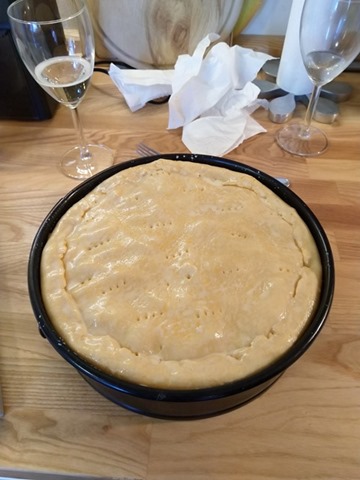
Bake at 200°C for ten minutes, then 180°C for 50 minutes. The pie should be nicely browned. Remove from the oven and rest for ten minutes while finishing off accompaniments (for our Christmas Day lunch this meant roast potatoes, sprouts, peas, bread sauce and onion gravy!).
The pie should hold together reasonably well on cutting into slices, and will keep well for Boxing Day picnics. Leopard Pie Curry is not a thing.
Here’s the pie just out of the oven (onion gravy in the background):
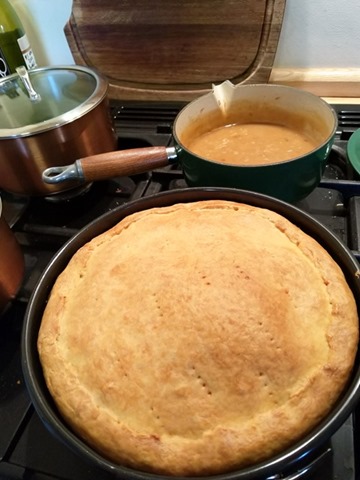
And after carving and serving half of it. Eagle-eyed observers might spot some chick peas – that’s right, and I left them out of the recipe above as we didn’t think they were needed.
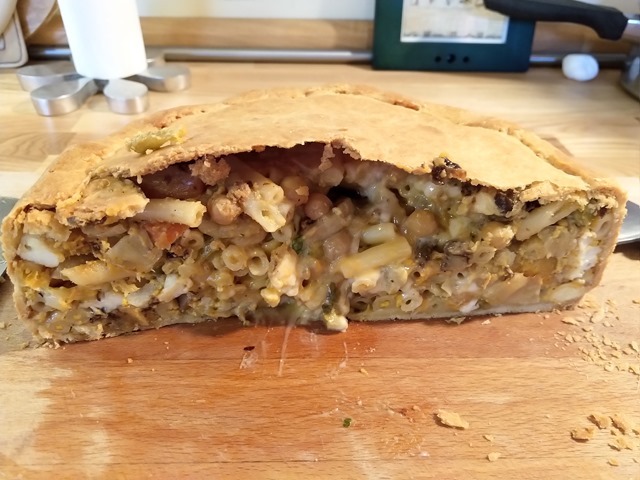
Why not give it a go, and please feel free to comment below with any suggestions!